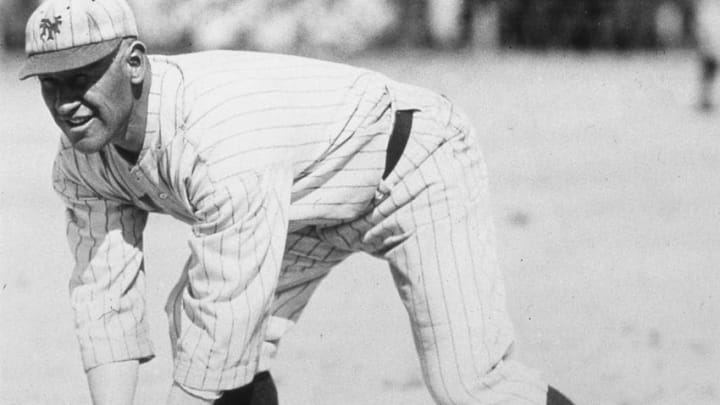One of the greatest athletes in history, Jim Thorpe was a solid baseball player, progressing every season. On what would have been his 131st birthday, let us look back at his career.
Jim Thorpe was a star athlete regardless of what sport he played. he had been a two time All American at football while playing for the Carlisle Indian School, the same school that produced future Hall of Famer Chief Bender. Thorpe played two seasons of semi-pro baseball, but became a national icon when he won two Olympic gold medals in 1912, setting a record in the decathlon. However, his time in professional baseball became known, and Thorpe was stripped of his medals, only to be posthumously rewarded them once again in 1983.
Given his baseball experience, and his immense popularity, he was signed by the New York Giants and John McGraw, theoretically as an outfielder. However, Thorpe was more of a publicity stunt, sporadically playing during his first three seasons. From 1913 through 1915, Thorpe had just 122 plate appearances, struggling to .195/.217/.271 batting line.
Sent to the Milwaukee Brewers of the American Association in 1916, Thorpe proved he was more than just a publicity stunt, as he performed well in AA. He produced a .274 batting average, hitting 25 doubles, 14 triples, and ten homers in his 573 at bats. Back with the Giants to start the 1917 campaign, he again played sporadically, receiving just two plate appearances in four games.
More from Call to the Pen
- Philadelphia Phillies, ready for a stretch run, bomb St. Louis Cardinals
- Philadelphia Phillies: The 4 players on the franchise’s Mount Rushmore
- Boston Red Sox fans should be upset over Mookie Betts’ comment
- Analyzing the Boston Red Sox trade for Dave Henderson and Spike Owen
- 2023 MLB postseason likely to have a strange look without Yankees, Red Sox, Cardinals
Fed up with Thorpe’s constant demands to play more, the Giants sent him to the Reds. There, he finally got a chance to play in the majors, and performed relatively well. He produced a .247/.267/.367 batting line, hitting four homers and eight triples. Thorpe also drove in the only run in the dual no hitters thrown by Hippo Vaughn and Fred Toney, allowing Toney to get his place in history.
Thorpe was sold back to the Giants later that year, but struggled in his 67 plate appearances for the team. He remained with the Giants in 1918, once again filling a part time role. In his 119 plate appearances that year, Thorpe had a .248/.286/.381 batting line with nine extra base hits. However, when the 1919 season started, Thorpe was once again a somewhat forgotten player on the Giants bench.
Once again looking to play more, he was traded to the Boston Braves for Pat Ragan. This time, Thorpe excelled, becoming one of the better hitters on the Braves. He produced a .327/.360/.429 batting line, hitting seven doubles and three triples. However, that would be his final season in the majors, as he spent the next three years playing minor league ball.
Greater things awaited Thorpe outside of professional baseball. He became one of the first professional football stars, and was the first president of what would eventually become the NFL. He spent nine years in professional football, being named to the first All Pro Team and eventually being inducted into the NFL Hall of Fame. Thorpe even played basketball for a couple of years, the main attraction of the LaRue Indians, a barnstorming team that Thorpe was the featured player on.
However, once his sports career ended, he struggled. Thorpe was married three times, having eight children, but was unable to provide for them financially. He struggled to keep a job, working an an extra in movies, digging ditches, and even serving in the Merchant Marine in 1945. He was broke when admitted to the hospital for lip cancer in 1950, and when he passed away in 1953, was penniless, having been exploited out of his earnings.
The greatest athlete of the first half of the 1900s, Jim Thorpe was a star in virtually every sport he played. He proved that to be the case in professional baseball as well, at least when he was given a viable opportunity.
